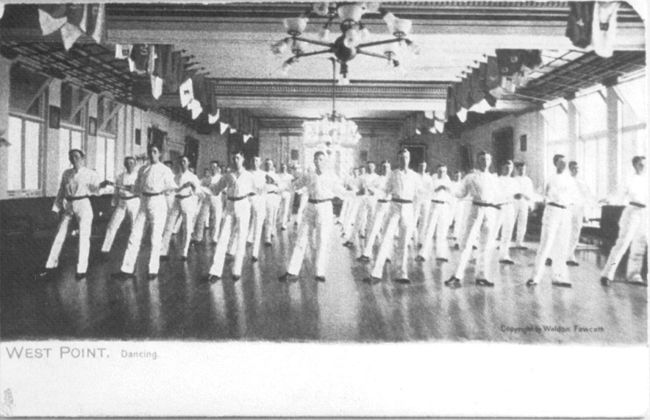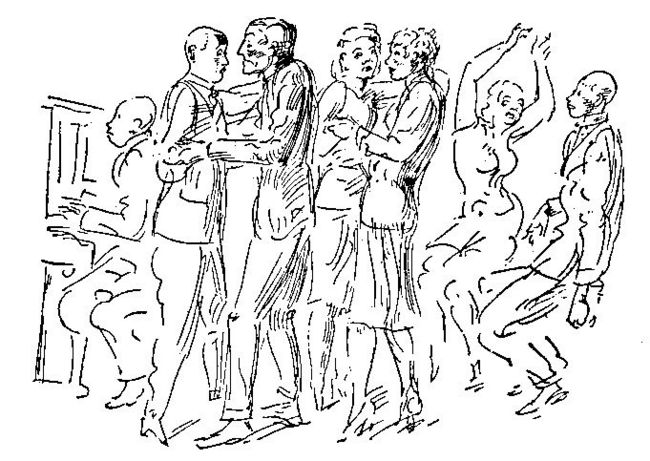U.S. Military Academy at West Point
A photographic postcard from the early twentieth century (exact date unknown) shows male recruits holding hands as they practice formal dancing with each other. It is captioned: "West Point. Dancing".
Information on the back of this postcard includes:
- Raphael Tuck & Sons' Post Card Series No. 2322, "Life at West Point" Art Publishers To Their Majesties The King and Queen."
A text explains:
- DANCING is a compulsory branch of instruction during two years of the four-year course. "Hops" are held on Saturday evening every two weeks throughout the term, and there are also additional events in the way of dancing graduation week and other periods of special festivity.
Here, in this evidence from American popular culture of the early 1900s, formal male-male dancing at the U.S. Military Academy at West Point was publicized as an innocent, if quaint custom. By the 1930s, at least, such physical contact between males, and such ambiguity of role, would become suspect, especially in those sexually segregated military training institution designed to produce "men" and fighters.[1]
According to the early homosexual emancipationist Edward Stevenson, a book, The Spirit of Old West Point, 1858-1862 (Boston: Houghton Mifflin, 1907) "presents the military souvenirs of General Morris Schaff, of the United States Army.... In its author's pen-portraits of early friends in the famous Military Academy . . . are to be noted many delicate suggestions of the uranian emotion in young and soldierly comrades. Indeed the accent of a manly similisexualism of psychic quality pervades the record.... Especially in its elegiac passages, it is eloquent of the homosexual thrill in young hearts that beneath uniforms can beat so passionally for each other."[2]
The Autobiography of Admiral George Dewey (N. Y.: Scribner's, 1913, p. 17) refers to a "stag hop."[3]
(OutHistory asks interested researchers to provide quotes from and additional descriptions from the above sources, including page numbers.)
By 1946, an image presented men dancing with men (and women dancing with women) as what was called "sexual perversion".
John Dos Passos' novel, The Big Money, first published in 1936, includes a scene in which a white woman and man on a date go to a Harlem night club where each dances with members of their own sex.
A drawing by artist Reginald Marsh (from the 1946 edition of the book) depicts two women and two men dancing together. It marks a historical change in the meaning of same-sex dancing and such images. From a time when they represented, merely, a curious quaint custom, to 1946, when the present sktech depicts, in the novel's context, a contact with explicit homoerotic connotations.[4]
See also: Corey Kilgannon, "At West Point, Hidden Gay Cadets Put in Spotlight." New York Times, August 24, 2010, page A1. See: http://www.nytimes.com/2010/08/25/nyregion/25cadet.html
References
- ↑ Re-edited from Jonathan Ned Katz, Gay/Lesbian Almanac (NY: Harper and Row, 1993), p. 318).
- ↑ Xavier Mayne (pseud. of Edward Stevenson), The Intersexes (c. 1908), pp. 209-10. This information first appeared in Katz, Gay/Lesbian Almanac, p. 318.
- ↑ This information first appeared in Katz, Gay/Lesbian Almanac, p. 318.
- ↑ This information first appeared in Katz, Gay/Lesbian Almanac, p. 524-26.

